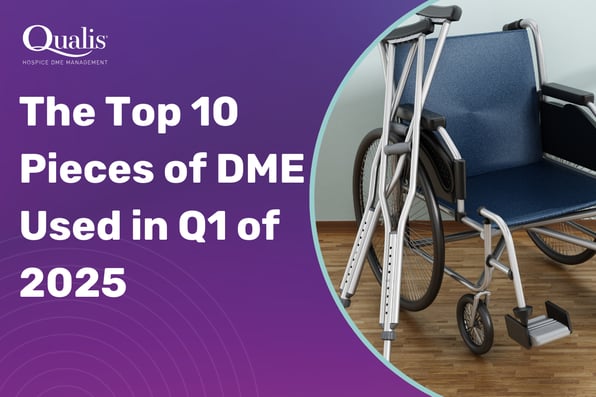The Top 10 Pieces of DME Used in Q1 of 2025

Ordering and tracking durable medical equipment (DME) is one of the most important tasks for hospice, PACE, and palliative care providers. Ensuring that patients have the equipment they need when they need it is critical to care delivery. Many common DME management headaches—like last-minute orders or delays—can be avoided just by knowing which items are most in demand.
One way to simplify DME management this year is by staying informed about the most-used DME in 2025, both within your organization and more generally. Knowing about durable medical equipment trends helps you identify what your DME ordering needs are likely to be. You can be more strategic with budgeting when you have a sense of what your hospice equipment needs will be. You can also establish a network of vendors that can meet your DME needs so you can get the right equipment to your patients without delays.
The Top 10 Most-Used DME Items in Q1 2025
Qualis has been tracking the top DME orders in 2025. Knowing which items are in high demand can help you plan ahead to best care for your patients.
10. Power Pressure Reducing Air Mattress (Low Air Loss Mattress)
Hospice patients are often most comfortable lying down in bed. However, even the most comfortable regular mattress can cause pain at pressure points or lead to skin ulcers from continuous pressure. Pressure-reducing mattresses use electrical-powered air pumps to automatically inflate and deflate air cells within the mattress. Changing the mattress firmness reduces discomfort and decreases the risk of pressure wounds.
9. Alternating Pressure Pad & Pump
Alternating pressure pads are another solution for making patients more comfortable. These devices are mattress toppers that can be laid over a standard mattress. They provide similar pressure relief as mattresses, but at lower cost. They can be used in any bed and may be compatible for use in chairs as well.
8. Portable Oxygen Cylinder System
Many hospice patients have compromised breathing and will require oxygen support. Portable oxygen devices are useful for patients who might need to ride in a car. They also allow patients to move about their home or sit outside while still getting the oxygen support they need.
7. Nebulizer
Nebulizers convert liquid medicine into a mist that patients can inhale using a mouthpiece or mask. They are vital therapeutic tools for administering medicine to patients with respiratory conditions like COPD or pneumonia.
6. Wheelchair
Wheelchairs are one of the most recognizable types of durable medical equipment. They provide mobility for patients who cannot walk on their own.
Wheelchairs can be customized to accommodate a wide range of patient needs, so it's important to order the right type of wheelchair for the patient's specific needs.
5. Oxygen Tank Refill
Oxygen support systems require regular refills to work properly. Oxygen canisters are refillable, so families can return empty tanks and exchange them for full ones. Working with vendors to coordinate timely delivery of oxygen tanks is one of the most important DME functions for hospice providers.
4. Commode Chair
Commodes are essential devices for helping people who are receiving home care or are aging in place attend to bodily needs without undue strain on caregivers. They allow safe, accessible toileting for patients with mobility issues.
3. Total-Electric Bed with Mattress and Rails
Hospital beds are designed for medical caregiving, which is why they are so helpful for hospice care. They can accommodate medical equipment like oxygen support, and monitoring devices. The adjustable positioning improves patient comfort and makes it easier for caregivers to assists them . The rails prevent falls, which gives caregivers peace of mind.
2. Overbed Table
An overbed table is a simple but essential accessory for in-home hospital bed use. These tables are staples in the hospital setting because they allow independence and convenience for patients. Patients can reach what they need without calling for assistance, while caregivers can easily move the table to reach the patient.
1. 5-Liter Oxygen Concentrator
The 5-liter oxygen concentrator was the most-used DME item in Q1-2025. The concentrator removes nitrogen from the ambient air and delivers concentrated oxygen to the patient, usually via a nasal cannula. Concentrators don’t require oxygen tanks. The 5-liter size is portable, so patients can move it around the house and take it to medical appointments if needed.
How Qualis Can Help You Stay Ahead of Equipment Needs
Qualis is your one-stop solution for DME management. We stay on top of medical supply chain trends and work with a nationwide network of DME suppliers to ensure that you can get high-demand items when you need them.
Our intuitive digital platform puts all your hospice care’s DME orders in one place, so you can easily see your orders, delivery alerts, and monthly invoices. You can generate comprehensive DME usage reports, giving you valuable insight into your real-time equipment needs so you can plan ahead based on past data.
If you’re ready to simplify your DME management process, contact the Qualis team today. We’ll perform a complementary DME evaluation to optimize your supply chain management and show you how DME management software can improve your capacity to deliver outstanding patient care.

.webp?width=800&height=800&name=CAHPS-Whitepaper_Download%20(2).webp)


